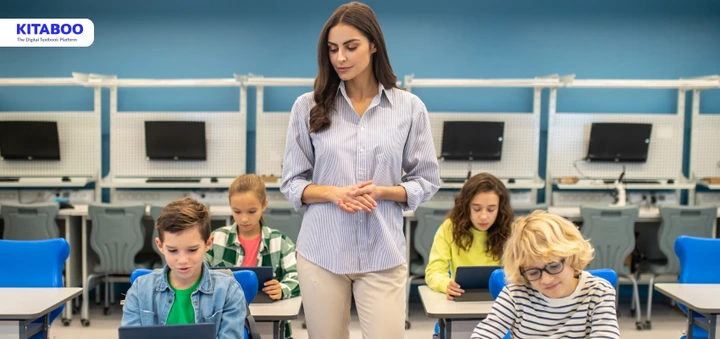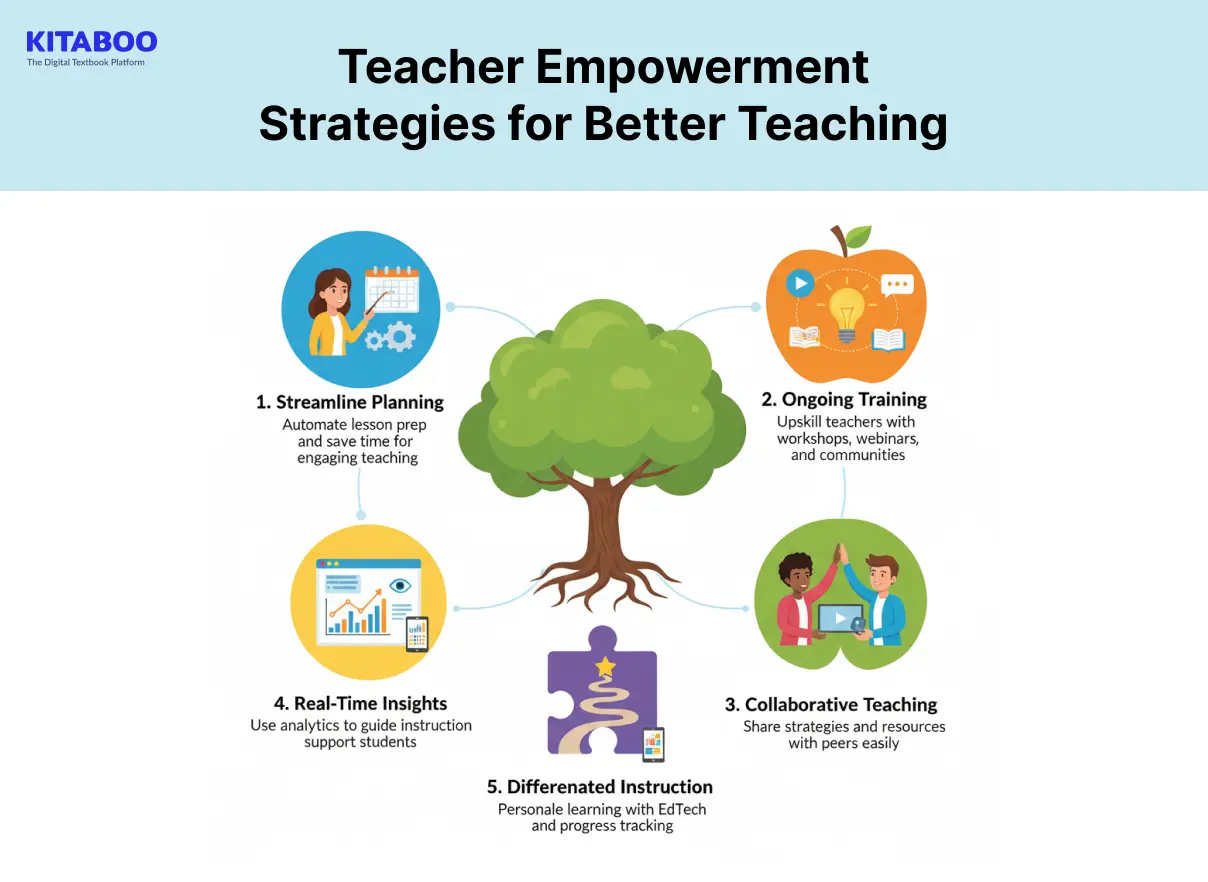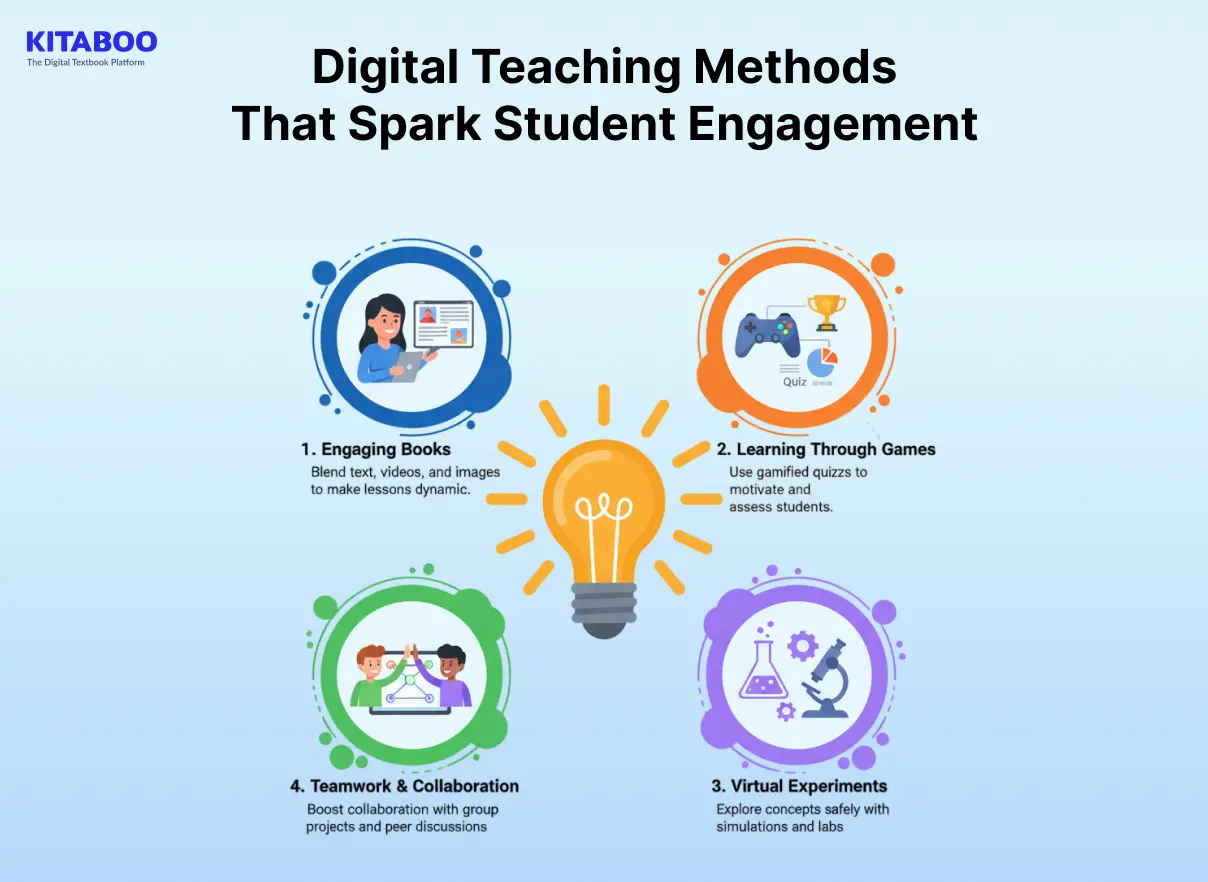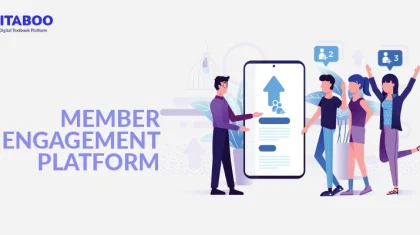
Empowering Teachers with Technology to Be Better Instructors
Summarize this blog with your favorite AI:
Empowering Teachers with Technology to Be Better Instructors - TL;DR
Teaching today comes with exciting opportunities and new challenges. Teachers juggle lesson planning, diverse student needs, and administrative tasks.
Empowering teachers with technology is essential for modern classrooms. Digital tools simplify work, boost confidence, and improve learning outcomes.
Key Takeaways:
- Teacher empowerment strategies enhance confidence, efficiency, and classroom effectiveness.
- A student-centric education model helps teachers personalize instruction for every learner.
- Digital classroom teaching methods like interactive eBooks, quizzes, simulations, and collaborative tools increase participation and understanding.
- Differentiated instruction with EdTech and progress monitoring in classrooms support targeted interventions for better outcomes.
- KITABOO brings all these strategies together with interactive content, gamification, adaptive learning, and analytics.
With KITABOO, teachers can save time, track engagement, and continuously refine lessons. Request a demo to see your teachers become extraordinary instructors.
Sometimes, the same thing can be equally exciting and challenging. Be it your fitness goals, business goals, or academics. One thing that can fit right in that list is modern-day teaching.
Teachers are staring at a plethora of opportunities sandwiched between several new challenges. The learning landscape is evolving, and student expectations know no limits.
However, the rapid advancements of learning technology are putting teachers in a very exciting position. They have the capabilities and tools to really transform learning and inspire a new generation of learners.
For this to happen, K12 schools and institutions must focus on empowering teachers with technology.
Table of Contents
I. What Are the Teacher Empowerment Strategies to Improve Effectiveness?
- Streamline Lesson Planning and Administrative Tasks
- Encourage Continuous Professional Development and Training
- Facilitate Collaborative Teaching and Peer Support
- Enable Real-Time Feedback and Analytics for Improvement
- Differentiated Instruction with EdTech and Progress Monitoring
II. How Can a Student-Centric Education Model Help Teachers Personalize Instruction?
- Personalized Learning Paths
- Supporting Diverse Learning Styles
- Real-Time Engagement Tracking
- Encouraging Active Participation
III. What Modern Digital Classroom Teaching Methods Can Boost Student Engagement?
- Interactive eBooks and Multimedia
- Gamified Quizzes and Challenges
- Simulations and Virtual Labs
- Collaborative Learning Platforms
IV. How Can KITABOO Help Teachers Become Better Instructors?
- Create Interactive and Engaging Lessons
- Gamify Learning to Boost Motivation
- Personalize Instruction for Every Student
- Track Engagement and Performance Instantly
- Simplify Lesson Planning and Delivery
V. Conclusion
VI. FAQs
What Are the Teacher Empowerment Strategies to Improve Effectiveness?
Teachers juggle lesson planning, diverse student needs, and administrative tasks every day. Empowering teachers with technology simplifies work and boosts classroom impact.
1. Streamline Lesson Planning and Administrative Tasks
Empowering teachers with technology allows them to automate lesson planning. Digital platforms organize resources, align them with curriculum standards, and suggest interactive elements like quizzes and multimedia.
This saves hours previously spent on manual preparation. Teachers can focus on designing engaging lessons, improving overall classroom effectiveness. Streamlined planning also ensures consistency across multiple classes.
2. Encourage Continuous Professional Development and Training
Ongoing learning is vital for educators to adopt digital classroom teaching methods effectively. Teacher empowerment strategies include structured training, webinars, and collaborative learning communities.
These initiatives build teacher confidence and help them integrate technology seamlessly. Educators learn to customize lessons for diverse learners, increasing engagement and instructional impact.
3. Facilitate Collaborative Teaching and Peer Support
Collaborative learning platforms let teachers share lesson plans, strategies, and interactive content. Empowering teachers with technology promotes cross-classroom learning and professional networking.
By exchanging best practices, teachers refine their techniques and adopt innovative approaches. Peer collaboration also reduces isolation, increases confidence, and accelerates skill development in handling modern classrooms.
4. Enable Real-Time Feedback and Analytics for Improvement
Digital tools provide instant insights into student performance. Empowering teachers with technology through live assessments allows immediate intervention for struggling learners.
Teachers can personalize learning and foster a more responsive learning environment. Real-time feedback not only improves student outcomes but also strengthens teacher confidence in decision-making.
5. Differentiated Instruction with EdTech and Progress Monitoring
Combining differentiated instruction with EdTech platforms and progress monitoring in classrooms enables tailored learning for each student. Teachers can track comprehension, engagement, and mastery in real time.
Empowering teachers with technology helps identify learning gaps and implement interventions quickly. This strategy ensures that every learner progresses while teachers optimize their instructional approach for efficiency and effectiveness.
How Can a Student-Centric Education Model Help Teachers Personalize Instruction?
A student-centric education model focuses on each learner’s unique needs. Teachers use technology to adapt lessons for every student.
Digital tools make it possible to empower teachers with technology, allowing them to create personalized learning experiences that improve outcomes.
1. Personalized Learning Paths
Empowering teachers with technology enables them to design learning paths that adjust to each student’s abilities. Students move at their own pace while teachers monitor progress. This tailored approach increases engagement and motivation. Technology ensures instruction is always responsive to individual needs.
2. Supporting Diverse Learning Styles
A student-centric education model recognizes that students learn differently. Interactive eBooks, videos, and simulations help teachers address visual, auditory, and kinesthetic learners. Digital classroom teaching methods make this seamless without extra effort, ensuring all students engage meaningfully.
3. Real-Time Engagement Tracking
With progress monitoring in classrooms, teachers see who is participating and who needs support. Instant data helps teachers intervene promptly. This prevents students from falling behind and allows instruction to be more effective and targeted.
4. Encouraging Active Participation
Digital classroom teaching methods promote collaboration and hands-on learning. Teachers can assign interactive projects and quizzes, fostering student participation. This approach helps teachers maintain engagement while delivering instruction that meets diverse learner needs.
What Modern Digital Classroom Teaching Methods Can Boost Student Engagement?
Modern classrooms thrive when teachers use digital classroom teaching methods effectively. Technology transforms lessons into immersive, interactive experiences.
1. Interactive eBooks and Multimedia
Interactive eBooks combine text, videos, and images, creating lessons that capture attention. Empowering teachers with technology allows them to customize content and track student engagement. Students explore concepts actively, improving understanding and retention.
2. Gamified Quizzes and Challenges
Quizzes with points, badges, or timed challenges motivate students to participate. Teachers can use digital classroom teaching methods to make assessments engaging while monitoring performance. Gamification increases focus and drives better learning outcomes.
3. Simulations and Virtual Labs
Virtual experiments and simulations let students explore concepts hands-on safely. Empowering teachers with technology enables real-time guidance and adjustments. These methods make abstract ideas tangible and encourage critical thinking.
4. Collaborative Learning Platforms
Tools for group projects, peer discussions, and shared assignments boost teamwork. Digital classroom teaching methods allow teachers to monitor contributions and guide collaboration efficiently. Students develop communication skills while staying actively engaged.
How Can KITABOO Help Teachers Become Better Instructors?
KITABOO brings all the strategies and methods we discussed to life, making teaching smarter, faster, and more engaging. By empowering teachers with technology, Kitaboo transforms lesson delivery, tracking, and personalization into a seamless experience.
1. Create Interactive and Engaging Lessons
With KITABOO, teachers can build interactive eBooks, videos, and simulations that make learning immersive.
These digital classroom teaching methods increase participation and help students grasp concepts faster.
Teachers save time designing lessons while keeping students fully engaged. The interactive content also allows teachers to adapt lessons based on student responses, ensuring learning stays effective and personalized.
2. Gamify Learning to Boost Motivation
Teachers can add quizzes, challenges, and gamified activities that reward progress and participation. This motivates students to stay active in class while helping teachers monitor engagement easily.
KITABOO’s gamification features also support teacher empowerment strategies by giving educators tools to inspire and guide learners effectively.
Gamification data also helps teachers identify which activities resonate most, letting them fine-tune lessons for maximum impact.
3. Personalize Instruction for Every Student
KITABOO enables teachers tailor content to individual learning needs. Struggling students receive extra support, while advanced learners explore deeper material.
Combined with progress monitoring in classrooms, teachers can identify gaps and adapt instruction in real time.
Personalized dashboards also help teachers track each student’s progress, ensuring interventions are timely and effective.
4. Track Engagement and Performance Instantly
Real-time analytics help teachers see how students interact with content, track quiz results, and monitor reading habits. These insights allow for targeted interventions and continuous improvement.
KITABOO helps you adapt a student-centric education model and put students at the core of every strategy. Teachers can also generate reports to demonstrate progress and learning outcomes to administrators and parents.
5. Simplify Lesson Planning and Delivery
KITABOO streamlines lesson creation, distribution, and updates. Teachers spend less time on administrative tasks and more time focusing on teaching.
By empowering teachers with technology, KITABOO ensures educators can deliver high-quality lessons consistently across classrooms.
The platform also integrates with multiple learning management systems, making it easier to manage and deliver content seamlessly.
Conclusion
Empowering teachers with technology transforms classrooms into dynamic, student-focused learning hubs. With the right tools, educators can save time, boost confidence, and deliver lessons that truly engage every learner.
KITABOO combines interactive content, gamification, analytics, and adaptive learning, making it easier than ever for teachers to implement effective strategies and methods.
Don’t let your classrooms settle for ordinary. Request a demo and see how your teachers can become extraordinary instructors.
FAQs
Technology simplifies lesson planning, enables personalized instruction, and provides real-time insights. This supports teacher empowerment strategies and helps students learn more effectively.
Strategies include streamlining administrative tasks, using digital classroom teaching methods, tracking progress in classrooms, and leveraging interactive content. These approaches boost confidence and teaching effectiveness.
It allows teachers to personalize learning for diverse learners. Engagement, participation, and understanding increase while teachers can monitor progress efficiently.
Examples include interactive eBooks, quizzes, simulations, collaborative tools, and gamified lessons. They help teachers create immersive experiences that improve student participation and comprehension.
KITABOO offers interactive content, gamification, adaptive learning, and analytics. Teachers can customize lessons, track engagement, and continuously refine instruction for better learning outcomes.
Discover how a mobile-first training platform can help your organization.
KITABOO is a cloud-based platform to create, deliver & track mobile-first interactive training content.





